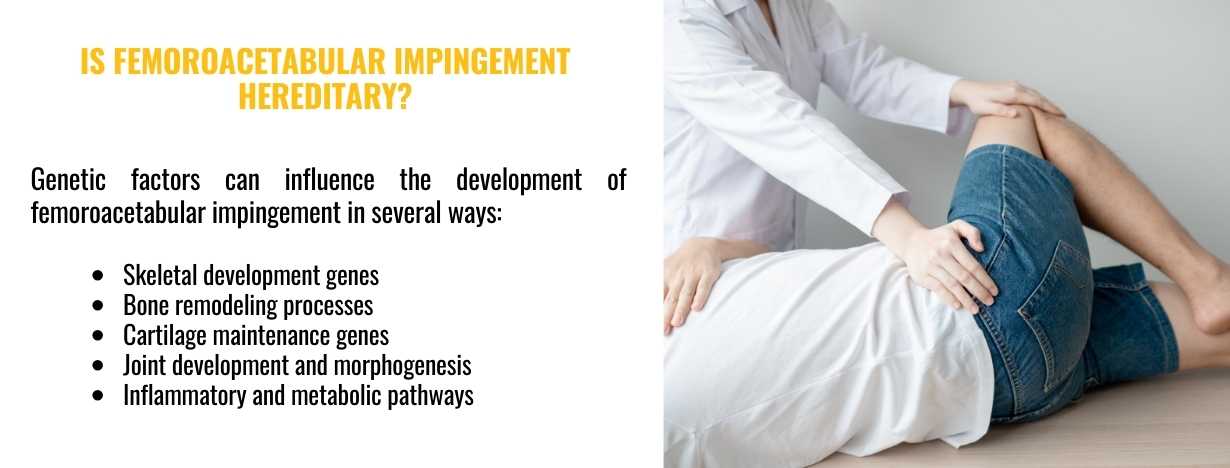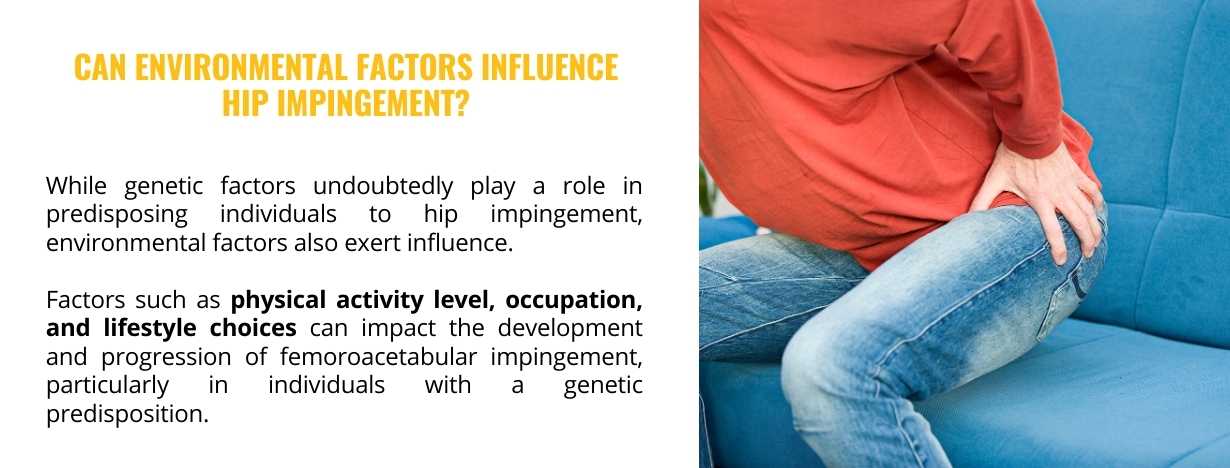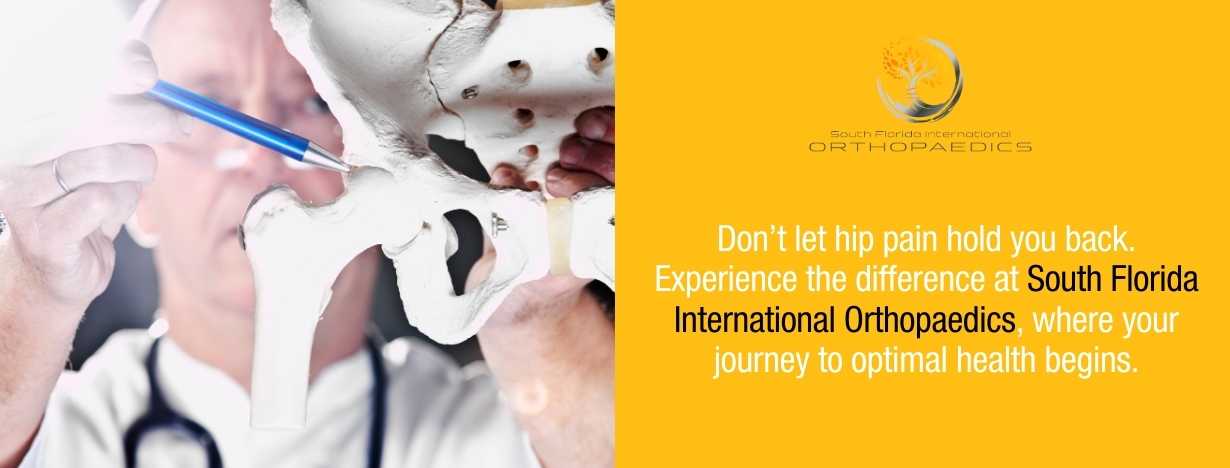Femoroacetabular impingement is a condition characterized by abnormal contact between the ball and socket of the hip joint, leading to pain and reduced range of motion.

While FAI is commonly associated with structural abnormalities in the hip joint, researchers have also investigated its potential genetic component. In this article, we’ll delve into the question: Is femoroacetabular impingement hereditary?
What is femoroacetabular impingement?
Femoroacetabular impingement, or hip impingement, is a condition characterized by abnormal contact between the ball (femoral head) and socket (acetabulum) of the hip joint.
This abnormal contact can occur due to structural abnormalities in either the femoral head, acetabulum, or both, leading to friction, inflammation, and eventual damage to the hip joint tissues. This condition can lead to various symptoms, such as:
- Hip pain
- Stiffness
- Reduced range of motion
- Clicking, popping, or locking sensations in the hip joint.
- Pain that worsens with prolonged sitting or physical activity.
- Pain that radiates to the buttocks or thigh.
Femoroacetabular impingement commonly affects young and active individuals, including athletes, but can also occur in older adults.
Are genetic factors involved in the development of hip impingement?
Genetic factors can influence the development of femoroacetabular impingement in several ways, contributing to the development of structural abnormalities in the hip joint.
Skeletal development genes
Genes involved in skeletal development play a crucial role in shaping the morphology of the hip joint during growth and maturation. Variations in these genes may lead to bone shape and size alterations, increasing the risk of hip impingement.
Bone remodeling processes
Genetic variations affecting bone remodeling processes can influence the balance between bone formation and resorption in the hip joint. Dysregulation of these processes may result in abnormal bone morphology and structural abnormalities conducive to FAI development.
Cartilage maintenance genes
The integrity of articular cartilage within the hip joint is essential for smooth joint movement and function.
Genetic variations affecting cartilage maintenance processes, such as extracellular matrix synthesis and degradation, may compromise the structural integrity of the cartilage and contribute to hip impingement development.
Joint development and morphogenesis
Variations in genes regulating embryonic limb patterning, joint capsule formation, and synovial membrane development could impact hip joint morphology and stability, increasing the susceptibility to impingement.
Inflammatory and metabolic pathways
Genetic variations affecting inflammatory and metabolic pathways may contribute to impingement development through their influence on joint inflammation, tissue remodeling, and metabolic processes.
Dysregulation of these pathways may exacerbate joint degeneration and contribute to the progression of FAI-related symptoms.
Can environmental factors influence the development of femoroacetabular impingement?
While genetic factors undoubtedly play a role in predisposing individuals to hip impingement, environmental factors also exert influence.

These factors interact with genetic susceptibility to modulate the expression and severity of the condition. Some key environmental factors that may influence the development of FAI include:
Physical activity level
Engaging in activities that involve repetitive hip movements, high-impact sports, or activities with increased hip flexion angles can exacerbate hip impingement and accelerate joint damage in individuals with a genetic predisposition to this condition.
Hip biomechanics
Alterations in hip biomechanics, such as hip joint laxity, hip muscle imbalance, or abnormal hip joint loading patterns, can increase the risk of impingement development in genetically susceptible individuals.
Lifestyle choices
Certain lifestyle choices can impact the development and progression of femoroacetabular impingement. Examples include:
- Obesity can exert mechanical stress on the hip joint and exacerbate impingement symptoms
- Smoking has also been associated with impaired bone healing and cartilage degradation, potentially worsening FAI-related joint damage.
Occupational factors
Occupational factors that involve prolonged sitting, standing, or repetitive hip movements may contribute to the development of hip impingement in genetically susceptible individuals.
Joint loading and injury history
Abnormal joint loading due to injury-related changes in hip biomechanics or joint morphology may exacerbate impingement symptoms and accelerate joint degeneration.
How can individuals identify their risk?
Understanding the hereditary nature of femoroacetabular impingement can help individuals identify their risk of developing the condition.
Individuals with a family history of this condition should be vigilant for symptoms and seek early evaluation if they experience hip pain or discomfort.
Additionally, doctors may recommend screening tests, such as hip imaging studies, to assess for structural abnormalities indicative of hip impingement in at-risk individuals.
What preventive measures can individuals take if femoroacetabular impingement runs in their family?
There are several preventive measures you can take to mitigate your risk of developing the condition or minimize its impact on your hip joint health. These are as follows:
- Maintain a healthy weight: Maintaining a healthy weight through a balanced diet and regular exercise can help reduce the risk of hip impingement and alleviate strain on the hip joint.
- Adopt proper body mechanics: Practice proper lifting techniques, avoid prolonged periods of sitting or standing in awkward positions, and prioritize ergonomic adjustments in your daily activities to reduce your risk of hip impingement.
- Engage in low-impact exercises: Opt for low-impact exercises that promote hip joint mobility, strength, and stability without placing excessive strain on the joint.
- Strengthen hip muscles: Incorporate targeted hip-strengthening exercises into your fitness routine to improve hip muscle strength and stability.
- Maintain flexibility and range of motion: Incorporate dynamic and static stretching techniques to improve hip joint mobility and prevent stiffness that may contribute to impingement symptoms.
Lastly, you can effectively prevent hip impingement by consulting with an orthopedic doctor. A hip specialist Kendall can provide personalized recommendations for preventive measures, screening tests, and treatment options based on your risk factors and health needs.
Discover Exceptional Orthopedic Care at South Florida International Orthopaedics

At South Florida International Orthopaedics, we understand the importance of restoring mobility and improving quality of life. Our specialists are committed to providing personalized treatment plans tailored to your needs. Besides hip impingement, we also treat various hip conditions, such as:
- Hip pain
- Hip labral tears
- Osteoarthritis of the hip
- Hip bursitis
- Hip fractures
- Muscle injuries of the hip
- And more!
Our comprehensive approach combines cutting-edge technology with compassionate care. From conservative treatments to innovative surgical solutions, we prioritize your well-being every step of the way.
Don’t let hip pain hold you back. Request an appointment today and discover why we are the top choice for orthopedic care and Kendall sports medicine.
The material contained on this site is for informational purposes only and DOES NOT CONSTITUTE THE PROVIDING OF MEDICAL ADVICE, and is not intended to be a substitute for independent professional medical judgment, advice, diagnosis, or treatment. Always seek the advice of your physician or other qualified healthcare providers with any questions or concerns you may have regarding your health.
